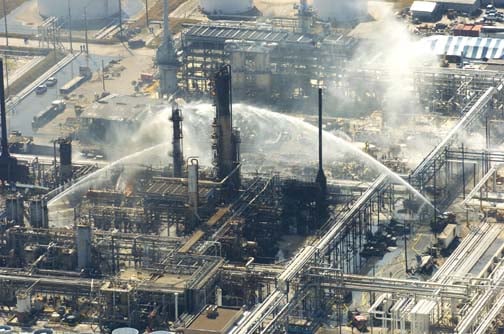The below Mar. 20, 2019 news release is from the California Environmental Protection Agency Air Resources Board.
California air quality regulators today [Mar. 20, 2019] released a report recommending actions to improve emergency and routine air monitoring at California’s major oil refineries and in the communities that surround them.
“Many communities near major refineries live in fear of exposure to airborne pollutants during a major refinery incident — or during normal operations,” CARB Executive Officer Richard W. Corey said. “The recommendations in this report will help to better assess and reduce the risks associated with long-term community exposure to routine and fugitive air releases. They also improve the rapid detection and communication of potentially hazardous releases during an emergency.”
The report lays out a four-part approach for improving air monitoring, modeling and communication around California’s major refineries:
- Expand air monitoring within refineries, at the fence line and in nearby communities;
- Improve modeling techniques to better predict impacts of pollution and incidents at refineries;
- Provide real-time information about air quality near refineries to first responders and the public; and
- Improve state and local coordination through an interagency refinery monitoring working group.
Authored by the California Air Resources Board and the California Air Pollution Control Officers Association (representing the state’s 35 local air districts), the report also recommends first responders have access to improved air monitoring tools and data, and they be thoroughly trained to apply them.
The CARB-CAPCOA report is part of a broader initiative set in place in 2013 to address refinery safety and emissions in response to a major fire in 2012 at the Chevron Refinery in Richmond. The fire raised concerns related to refinery maintenance and safety, and emergency preparedness, at and near California’s oil refineries. Air regulators presented a draft of the report, released in fall of 2017, at a series of meetings in California communities most impacted by potential and actual refinery emissions.
Actions recommended in the final report aim to strike a balance between local implementation of stronger air monitoring and communication systems, and state oversight. A proposed interagency working group, which would be comprised of staff from CARB and local air districts, would develop guidelines that air districts use in requiring refineries to expand air monitoring networks and making the data available to first responders and the public.
The refinery-focused guidance could serve as a future template for similar air monitoring around other types of industrial sources that pose a risk to nearby communities.
California already has begun to address some of the report’s findings and recommendations. Several recent California statutes and regulations now improve refinery emergency preparedness, require community air monitoring, improve notification systems and establish permanent refinery oversight. One example, Assembly Bill 1647, includes new requirements for significantly enhanced fence-line and community-level air monitoring at and near refineries. Findings of the CARB-CAPCOA refinery-focused report will also be a useful resource as CARB and air districts work with stakeholders to implement California’s Community Air Protection Program under AB 617, enacted in 2017.
The report takes into account the refinery chemicals of highest concern as identified in a companion report also released today by the California Office of Environmental Health Hazard Assessment (OEHHA). This report, “Analysis of Refinery Chemical Emissions and Health Effects,” presents a list of chemicals emitted from California refineries and prioritizes the chemicals according to their emissions levels and toxicity. The report covers emissions that occur routinely in daily operations, as well as potential emissions from an accidental or other non-routine release.
The report supports the goals of the Interagency Refinery Task Force, established in response to concerns raised in the aftermath of the Chevron Refinery fire in 2012. As part of a broader effort to improve the coordination of refinery safety and compliance efforts, and improve emergency response capabilities, CARB and CAPCOA agreed to assess existing emergency air monitoring capabilities and identify potential improvements to refinery air monitoring systems. The agencies released an inventory of air monitoring and response capabilities for each major refinery in May 2015.
For more from the “Air quality regulators call for improved monitoring at California refineries, surrounding communities,” Mar. 20, 2019 news release, click here.

Image above: Chemical safety and hazards investigation board
Published by Alan Kandel